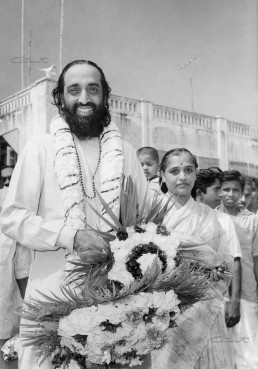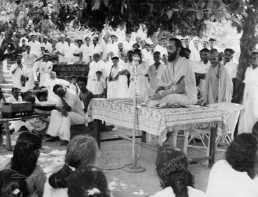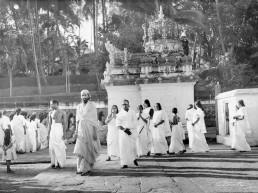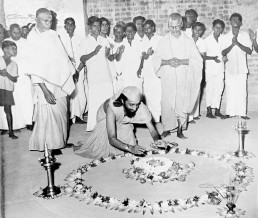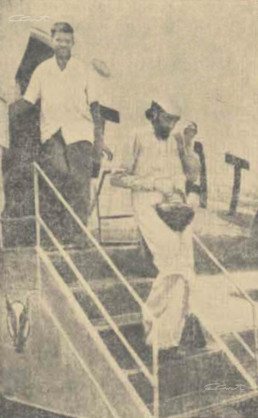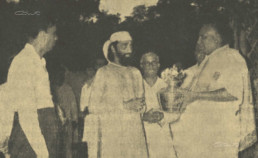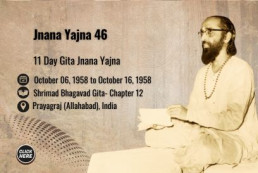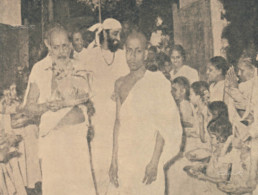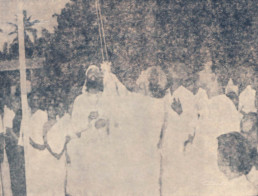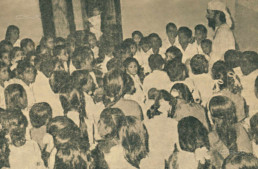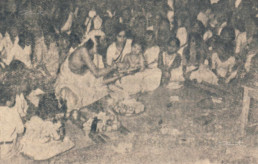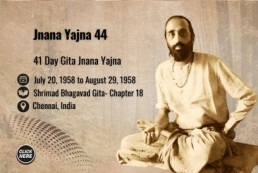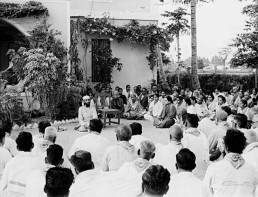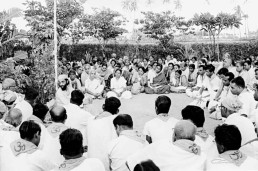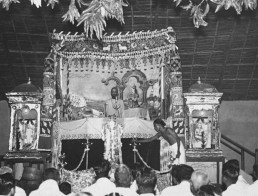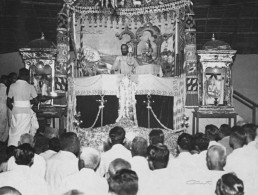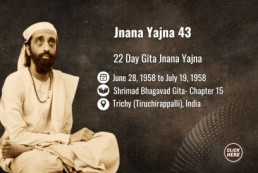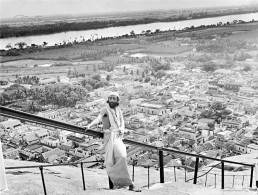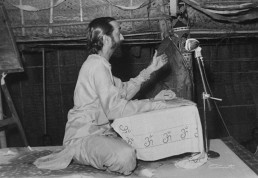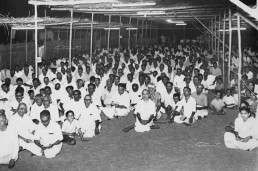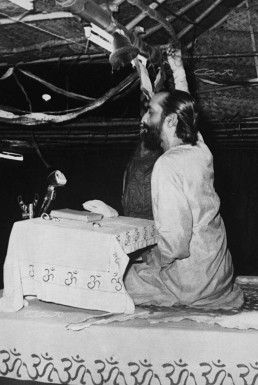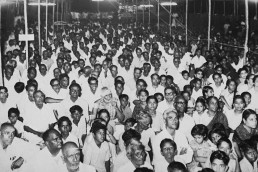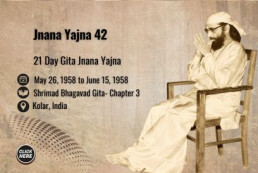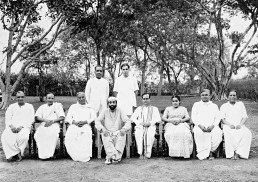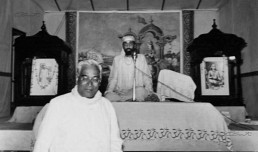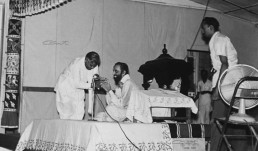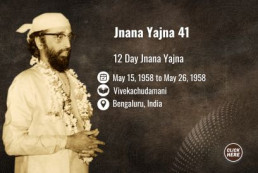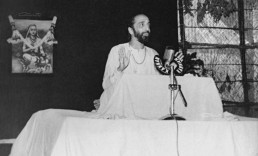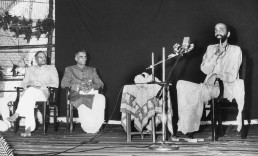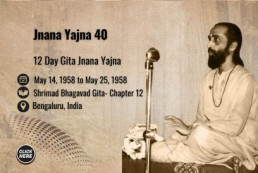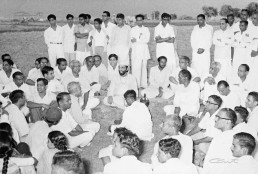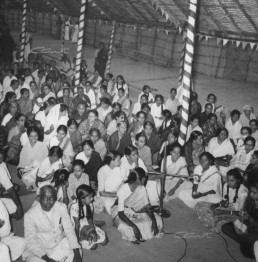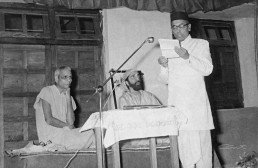Jnana Yajna 48
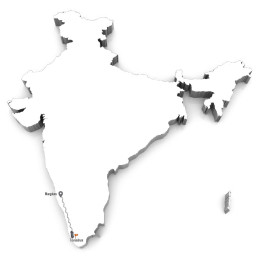
Jnana Yajna 48

Year & Dates:
November 13, 1958 to December 03, 1958

Yajna Topic:
Shrimad Bhagavad Gita- Chapter 3

Place:
Thiruvananthapuram (Trivandrum), India.
Bhagavan’s Divine Song was going to flow again through the Chinmaya Flute, and the biggest pandal in Thiruvananthapuram with a capacity of 8000 to 10000 awaited its mellifluous inauguration in the 48th Jnana Yajna on November 13, 1958 by Her Highness Maharani Sethu Parvathi Bai of Travancore. After her words on the need for resurgence of ancient Vedic wisdom, Pujya Gurudev opened His discourse with an optimistic note. While the western world had done much to raise the standard of living, He said, the sages of India delved deeper to elevate the standard of life. Despite the Atomic Age and decades of colonial rule, India was waking up to relook at Her culture, and “revival of Vedanta was the revival of the nation.”
Raising the Standard of Life
The melody of Srimad Bhagavad Gita’s chapter 3 drew more each evening as Pujya Gurudev instructed how to sublimate self-centered actions into Karma Yoga, the path of action without attachment. Focusing on Bhagavan Krishna’s description of how the entire world turns on the wheels of action, He highlighted the importance of doing one’s bounden duty, egoless, and with devotion.
After a powerful Akhanda kirtan and Gita Havan, Pujya Gurudev planned for the devotees of Trivandrum a memorable Avabhrta Snaana in the Thamirabarani river flowing through Tirunelveli In Tamil Nadu. The yatra at the end of the Jnana Yajna was not just a spiritual picnic; the attitude of traveling in satsang, bhajans, and constant remembrance of the divine presence in everything transformed the pilgrims’ perspective. The sacred dip in the waters was not just energizing but also sanctifying. When Pujya Gurudev led them to the ancient Nellaiappar Temple where Bhagavan Shiva had performed penance and His Cosmic Dance, where Bhagavan Vishnu as Nellai Govinda blessed and solemnized the divine wedding of Bhagavan Shiva with Kantimathi (Goddess Parvati), the importance of worship was experienced. The astonishing craftsmanship of the famous musical pillars in the Mani Mandapa, the Taamra (copper) Hall of Dance with its intricate woodwork, and the shrines of various Gods inside the sprawling temple reminded people of the land’s sacred heritage. Pujya Gurudev also took them to Cape Comorin for another unforgettable darshan of Devi Kanyakumari before the huge group returned to Trivandrum bathed in a bliss they had failed to recognize before.
Pujya Gurudev, bringing out the warbling wisdom of the melodic Gita in His 48th Jnana Yajna, appealed to the devoted audience to infuse their lives with noble values. That would lead to an inspired standard of life rather than just an externally prosperous standard of living.
Photo Gallery

“Think,” Says Pujya Gurudev
Karma Yoga is a way of life, and we have to live it if we want to come under its grace.
The Path-of-work lies through a process of elimination of the desires in us. When egoism and ego-centric desires are eliminated the work accomplished through such an individual is the true divine action, which is destined to have enduring achievements. To the extent man is not practicing this efficient Way-of-Work, he should grow necessarily unintelligent, and to that extent his discriminative capacity should be found deteriorating and ultimately destroyed.
From Yajna Prasad
Stop this Now!
What can ancient wisdom teach us about the importance of mutual cherishing between humanity and nature? Can we extract valuable lessons from humanity’s transition from arrogance to harmony in our interaction with the environment? Let’s delve into the potential of cooperation to drive transformative change towards a sustainable future for all beings.
Jnana Yajna 47

Jnana Yajna 47

Year & Dates:
October 20, 1958 to November 09, 1958

Yajna Topic:
Kenopanishad

Place:
Mangaluru (Mangalore), India.
The 47th Jnana Yajna, the first of Pujya Gurudev’s Jnana Yajnas in the coastal city of Mangaluru and the 12th in the year 1958, was also the only Upanishad Jnana Yajna in 1958. When Pujya Gurudev landed on the morning of October 20, 1958, those who received Him were thrilled. More invigorating was when He visited the yajnashala in the Government College playground even before He went to the guesthouse to rest. The organizers were amazed at the way He thoroughly inspected all arrangements for an efficient yajna – the 60’ x 120’ pandal, its bright, fluorescent lighting for aspirants to read the smallest print, the floor with sand for comfortable sitting, chairs only for the physically challenged, adequate loudspeakers, and the auspicious dias with the shining Om symbol and the portraits of Adi Shankaracharya and Parama Guru Swami Tapovanam – His powers of observation, organization, and execution were worth deep study in themselves.
A Jnani and Inimitable Leader
From the moment that Pujya Gurudev began His discourse with His resonating utterance of Om, the audience was mesmerized. Through the mornings with Atma Bodha and the evenings with Kenopanishad, the numbers of the attendees swelled so much that the pandal was extended. It was as though the whole place was in a spiritual trance – even the leaves of trees didn’t rustle as the air was calm; nobody in the thousands even sneezed, and until Pujya Gurudev concluded with “Tomorrow then…,” time seemed suspended.
The three-day Mrityunjya Havana conducted in perfect Vedic style reassured the orthodox that the modern Swami wasn’t one to decry rituals. The 3-day Akhanda Kirtan also gave everyone an opportunity to revel in devotion. On November 8th, when Pujya Gurudev concluded His pravachans, the adoring audience didn’t want to leave.
The final segment of the Jnana Yajna was an unforgettable ‘one-day’ sannyasa yatra to the most hallowed spot of Talakaveri, the source of the holy Kaveri river. Pujya Gurudev was like the Pied Piper and a stately Commander as He outlined the yatra plan and guidelines to the huge group in those 13 buses and 20 cars. The 106-mile drive in the panoramic Western Ghats with Bhajans and kirtans echoing through the countryside and mountains was heavenly, especially since Pujya Gurudev spent time in each bus. The way He cared for the pilgrims indicates the magnanimous love that He personified. He was the last one to board a bus, have tea or dinner, and He slept after everyone had gone to sleep. When He led everyone to the sacred birthplace of the Kaveri river to immerse the ashes of the Mrtyunjaya Havana and complete the Avabhrta snaana in the sacred temple tank, it was a transformational experience. Pujya Gurudev’s ability to guide and enlighten is legendary.
Photo Gallery

“Think,” Says Pujya Gurudev
Stop the mind. Then there is no world, Samsara. “Wake yourself up; that is all. And this we CAN do. That waking up can come only when we have come to the feet of our Guru, with a pure heart and a bright intellect enquiring to him, “where is the inner Self”. In delving into this Truth a Guide is absolutely essential for all but the exceptional few. From the outside we have to take a right-about-turn of our gaze and turn it inwards.
From Kenopanishad Yajna Prasad
In order to gain a godly fact or profit you have to live every moment vitally aware of what is happening not only outside ourselves but also in our own within. But unfortunately the instruments, our mind and intellect, are left to run into ruin. Just as the great-grand-father’s razor, they are left in the Wall-shelf rusting!! For generations past we have been allowing the mind and the intellect, our great instruments of knowing, understanding, feeling and thinking, to lie away in neglect. Let us repair and make use of them. It is accomplished by sincere and long Sadhana.
From Kenopanishad Yajna Prasad
What are Upanishads?
Gain insights into the dynamic interactions between students and teachers in the Upanishads, where diverse questions lead to tailored discussions. Discover how different approaches ultimately converge towards the highest state of consciousness.
Jnana Yajna 46
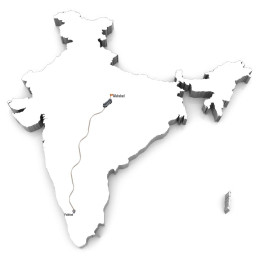
Jnana Yajna 46

Year & Dates:
October 06, 1958 to October 16, 1958

Yajna Topic:
Shrimad Bhagavad Gita- Chapter 12

Place:
Prayagraj (Allahabad), India.
When incessant rains in Delhi upstaged a Yajna in the capital city, fortune smiled on Prayagraj, also known as Prayagraj. Within 48 hours of planning on the telephone, the “Besant Memorial Hall,” which is the local headquarters of the Theosophical Society, morphed into an artistic and welcoming Yajnashala. Prof. Manorama Agarwal, the Secretary of Chinmaya Mission Prayagraj, mobilized an efficient team of sevaks, and Prayagraj was thrilled to receive Pujya Gurudev who chose the crisp and delightful Chapter 12 of Shrimad Bhagavad Gita for the 46th Jnana yajna there. Welcoming Pujya Gurudev and a packed audience on the evening of October 6, 1958, Prof. Hafiz Syed – a Muslim by birth but a Krishna Bhakta at heart – drew a parallel between Pujya Gurudev and Swami Vivekananda for their missionary zeal.
An Unexpected Divine Gift
Pujya Gurudev, everytime He expounded on the potency of devotion described in Gita’s chapter 12, told seekers that Bhakti was not the realm of mere emotion for a divine idol. It was the more subtle act of faithful attunement to the Highest Reality using the sacred form as the springboard – from Form to the Formless. Thus, every verse of chapter 12 signifies how a devotee can rise in love to merge with the Infinite. As Pujya Gurudev painted the profile of an inspired devotee detailing the attributes that Bhagavan Krishna had Himself enumerated, the audience at Allahabad were filled with the yearning to become that Bhakta who is most dear to Bhagavan. When He described the path of constant practice to uplift the mind, He reinforced that an emotional heart needed a balanced head; the individual must understand the Indivisible Essence.
Since the Jnana Yajna was of shorter duration than previous ones, both Akhanda Kirtan and a Gita Havana could not be done. However, Pujya Gurudev headed a vibrant procession of devotees riding on cycles, buses, and cars to Rasulabad with bhajans to worship in the temples of Prayagraj. Apart from the Gita discourses, Pujya Gurudev spoke on “Our Culture” at the Aeronautical Training Centre Club at Bamrauli.
Though the 46th Jnana Yajna was planned as an afterthought when rains hindered Pujya Gurudev’s discourses on Gita Chapters 5 & 6 at Delhi, it was a shining example of the resourcefulness of a young branch of Chinmaya Mission. Pujya Gurudev showered the blessing of divine Love to reward the way a sudden availability of an adored Guru was utilized respectfully.
Photo Gallery

“Think,” Says Pujya Gurudev
Man can worship the myriad forms through service, undertaken in a spirit of worship and divine dedication. By doing so, the body attachments and sense appetites get purged from his inner makeup and his mind becomes subtle enough to conceive and contemplate upon the Formless and the Imperishable Unmanifest.
From Bhagavad Gita- Chapter 12, Book
From Pointer to Pointed!
Dive into the profound wisdom of scriptures worldwide as they point towards the ineffable essence beyond words. Discover how descriptions of God serve as pointers, guiding our attention towards the infinite, eternal, and omnipresent. Join us on a journey of contemplation and meditation, unlocking the pure infinite self within.
Jnana Yajna 45
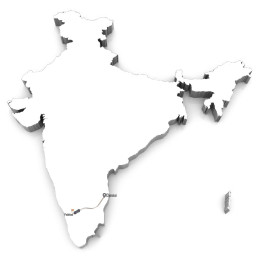
Jnana Yajna 45

Year & Dates:
September 03, 1958 to September 24, 1958

Yajna Topic:
Shrimad Bhagavad Gita- Chapter 12 & 13

Place:
Palakkad (Palghat), India.
The rain clouds had emptied themselves, washing the earth, like an anticipatory abhisheka. The monsoon’s intense downpour in Palakkad, which worried the organizers of the 45th Jnana Yajna, quietened as the sun shone with cheer; Pujya Gurudev was welcomed grandly with temple honors at the famous Bhagavati temple at Vadakkanthara on September 3, 1958. Inaugurating the Yagna, the Prince Marthanda Varman of Travancore pointed out how the Gita was taught “by the Lord Himself not in a classroom or under the shade of a tree but on a battlefront at a time when action was imminent.” Sri K.S. Ramaswami Shastri, a patron spoke on Gita’s universality saying: “It is a scripture for every member in the human family; it makes reference not to just Hindus and Indians alone, but addresses in general terms like Manusyha, Bhoota, Jana, Nara etc.”
Nourishing Young Ideals
Pujya Gurudev asked the audience to recognize how the Gita was a heroic manual not just in a crisis but in the game of life. It was about “how to receive stimuli from the world and send out readily the right responses – for a fuller, happier life.” The 21-day camp with Vivekachudamani classes in the morning and the yajna discourses on the Bhakti and Kshetra Kshetrajna Vibhaga Yogas immersed everyone in devotion and deep contemplation.
The youth of Palakkad Victoria College were specially blessed when Pujya Gurudev inaugurated their student union, reminding them about their duty to self and the world. On September 6th, He visited a children’s branch of the Mission at Marutharode near Palakkad. Speaking to parents, Pujya Gurudev placed emphasis on the betterment of children, for, at a tender age, it is easy to give their minds the right inclination and put them in the proper channel to grow. He noted how a spiritual culture was India’s flag post and reminded that Chinmaya Mission aimed at cultural renaissance which required the participation of children with their parents. The very young, the youth in their prime, the mature, and the aged – Pujya Gurudev embraced, encouraged, and enlightened without a pause. Palakkad and its surrounding villages were enchanted by the magnetic personality and the spiritual power of Pujya Gurudev.
The Gita Havana concluded on September 14th, and an enthusiastic group of adults and children boarded special railway carriages and buses with bhajans and kirtans for Avabhrta Snaana in Coimbatore. Pujya Gurudev arranged for a devotionally memorable trip with darshan at Perur Pateeshvara temple famous for its svayambhu linga and amazingly intricate sculptures. The 45th Jnana Yajna was another wholesome experience of spiritual living. And, Pujya Gurudev motivated blossoming generations to get enlisted in the Vedantic Renaissance.
Photo Gallery

“Think,” Says Pujya Gurudev
In all activities, a seeker should be, by the very nature of his philosophy, one who is ever devoted in tirelessly serving the entire living kingdom. Love for all beings becomes his creed; wiping away their tears and replacing them by smiles and laughter becomes his profession and life’s fulfillment.
From Bhagavad Gita- Chapter 12, Book
In this mechanical age, it is very easy to understand that there must be a field for an energy to play; and that then alone, it can manifest as work-done and serve man. Steam energy cannot be resolved into locomotion unless it is made to pass through a steam-engine. Electricity cannot give us breeze unless it passes through the engine of a fan. Thus an engine is the “field” through which the right type of energy, when sent, manifests. The equipments through which Life passes when an individuality is expressed, that assembly of matter-layers, is defined by Krishna as the “Field.”
From Bhagavad Gita- Chapter 13, Book
If you are Facing Terrible Sorrow!
Here is an excerpt from the teachings of Swami Chinmayananda on how to navigate the inevitable cycles of joy and sorrow in life. Discover how to maintain balance amidst life’s fluctuations by cultivating a steadfast devotion and unswerving focus on the divine. Learn to embrace each moment with equanimity, knowing that joy and sorrow are transient experiences on the path to spiritual growth.
Jnana Yajna 44

Jnana Yajna 44

Year & Dates:
July 20, 1958 to August 29, 1958

Yajna Topic:
Shrimad Bhagavad Gita- Chapter 18

Place:
Chennai, India.
The skies that poured over Chennai could not dampen the mounting sense of excitement in the four thousand seekers-admirers-disciples inside a spacious Pandal. On the evening of July 20, 1958, after the Governor of Madras, Shri Vishnuram Medhi invoked the Grace of Bhagavan Krishna and said, “May the discourse on Gita bring into bold relief the message of love, tolerance, truth and non-violence,” Pujya Gurudev voiced His inspiring preface: “Why do we seek a greater peace and happiness? Why not be content to be what we are? Something in each one of us tells us that what we have now is not the real peace; we feel that there is some higher peace which is our own. There is a standard in our mind, a vague ideal entertained by our intellect, which is the highest standard. Compared with that ideal peace, unknown – yet, not unknowable – the kind of joys, happiness, and peace we are familiar with seem to be sheer trifles and so mostly valueless.”
Path to Life-Fulfilling Peace
In His first 108 Jnana Yajnas, His 44th Jnana Yajna was the only yajna where He expounded on the final chapter of Shrimad Bhagavad Gita. Before Pujya Gurudev began the Jnana Yajna, He visited the revered Sankaracharya of Kanchi who was staying at the Sanskrit College in Mylapore (a Chennai suburb); the saint was observing silence and Pujya Gurudev offered His prostrations with respect and great humility. Pujya Gurudev’s exposition of Moksha Sannyasa Yoga started on that powerfully silent note. After a masterful outline of the previous 17 chapters, the greatest proponent of the Gita brought out the way to elevate life after progressing from Tamas (inertia) to Rajas (activity) and finally to Sattva (Knowledge). Through noble sacrifice, right understanding, selfless actions, fortitude, and true happiness, liberation in life is achievable, Pujya Gurudev reiterated. Clearly stating that healthy detachment (Tyaga) was required for true renunciation (Sannyasa), He presented the ultimate joy of liberating surrender and the sacred assurance of Bhagavan’s Grace.
The morning sessions of Kenopanishad and Isavasyopanishad were profound. The evening sessions increased the craving to grow noble, egoless, and devoted. To sweeten knowledge with devotion, a Laksharchana Devi Puja with continuous chanting of Lalitha Sahasranama and 100,000 flowers was performed to a beautifully adorned Goddess in the Yajnashala on August 10th. Lotus buds from Kolkata, pure-white carnations from Bengaluru, soft pink roses from Mumbai and garlands of all hues from Trichy, Mangaluru, Delhi, Tripunithura – the flowers came from everywhere and were offered all day by thousands. Pujya Gurudev also conducted an energizing Gita Havana, a highly cherished yatra for Avabhrta Snaana in the holy Kaveri of Sreeranga Kshetra, memorable darshans at the sacred temples of Shree Ranganatha and Sri Jambukeshwara. The finale before returning to Chennai was an exciting climb up the Rockfort hill to worship Bhagavaan Vigneshvara. Pujya Gurudev made everyone experience the liberating peace that passes all understanding in that extraordinary Jnana Yajna.
Photo Gallery

“Think,” Says Pujya Gurudev
In the very symbolism of the Gita-scene, Krishna, the teacher, is a mere charioteer ready to drive the chariot in any direction to which Arjuna, the master, shall command. Krishna bears no weapon; He has no war to wage. He has nothing to gain or lose in the fields of Kurukshetra. Yet, it is His duty to bring to the notice of His ‘master’ certain points of view, certain varieties which Arjuana seems to have not cared to recognize, or has overlooked because of the peculiar mental condition in which he was then. Having placed before him all the facts and figures of life, principles and methods of living, Krishna rightly invites Arjuna to make his own independent decision after considering all these points. Spiritual teachers should never compel. And in India, there has never been any form of indoctrination.
From Bhagavad Gita- Chapter 18, Book
Abandonment vs. Renunciation
Swami Chinmayananda in his inimitable style sheds light on the common confusion between “abandonment” and “renunciation” and their psychological nuances. through introspective contemplation, learn how letting go of desires and expectations leads to the transcendence of ego, paving the way for spiritual realization.
Jnana Yajna 43

Jnana Yajna 43

Year & Dates:
June 28, 1958 to July 19, 1958

Yajna Topic:
Shrimad Bhagavad Gita- Chapter 15

Place:
Trichy (Tiruchirappalli), India.
After the 42nd Jnana Yajna amid gold mines at Kolar followed the 43rd Jnana Yajna of Pujya Gurudev at a very different terrain – a railway colony which housed a workshop that repaired Royal Air Force planes during World War II. The place was called Ponmalai in Tamil and also known as Golden Rock, a zone assigned to the culturally rich city of Tiruchirappalli (Trichy) in Tamil Nadu. Arriving in Trichy on June 29th, Pujya Gurudev started His Gita Jnana Yajna at 7pm that evening, after prayers at Goddess Ponneshwari (a form of Goddess Parvati) Temple and the nearby Shri Ram Mandir. The topic chosen was ‘Purushottama Yoga’ Chapter 15 of Bhagavad Gita, and the diverse crowds of the ‘mechanical-minded’ community looked forward to the 22-day spiritual experience.
Adaptive, Supreme Teaching
Sri Krishna, Bhagavan Himself, was indicating the Supreme, Eternal, and Immutable Spirit through a spiritual allegory. The intriguing upside-down Tree-of-Life fascinated Arjuna then, and every seeker continues to wonder about that Subtlest Divine Source that enlivens every single aspect of our environment, body, mind, and intellect. Those 22 days at Ponmalai were truly more than golden. After introducing the upanishadic philosophy and the context of Bhagavan’s Divine Song, Pujya Gurudev raised the audience to a breathtaking combination of analysis, introspection, and immersion. He was explaining the most secretive Science of the Inexplicable, the Knowledge that would make the finite thinking individual dissolve. In the awe of That, all wisdom would be gained and all duties became complete.
Those 20 potent verses of chapter 15 to yoke to the Purushottama – Pujya Gurudev’s uplifting eloquence and electrifying emotion astounded the thousands. The Hindus, devout Christians, the pious Muslims, the people of all strata of society – for those 22 days, all differences disappeared in the brilliant Jnana Yajna.
The Yajna was held in the month of Adi that marks the onset of monsoon when rivers overflow and the winds become gusts. Since the yajnashala had a low roof, Pujya Gurudev substituted the Gita Havana with an elaborate Devi puja. With Lalitha Sahasranama chanted by the famous pundits of the Thiruvanaikoil Jambukeshwara temple, the audience gained the benefits of Kirtan, Japa, and Puja. In place of the sacred ashes from a havana-kund, Pujya Gurudev offered those flowers sanctified by puja to the sacred Kaveri river flowing through Trichy. When the 43rd Jnana Yajna concluded with the Ganga Prokshana (sprinkling), the audience of Ponmalai were bathed in the Supreme golden bliss.
Photo Gallery

“Think,” Says Pujya Gurudev
Consciousness is the Light in the Sun; it is the same Consciousness that fertilizes the Earth; the Consciousness as the Moonlight supplies food-value to the plant kingdom. It is Truth Itself as the body-warmth that presides over the assimilation of the food within the body and supervises the processes of life’s transactions with the world outside; and it is the same Light of Consciousness that makes it possible for us to gain experience, store away knowledge, and replace ignorance with better knowledge.
From Bhagavad Gita- Chapter 15, Book
Rare Fact about Ashwattha (Banyan) Tree!
Explore the etymology of “Ashwattha” and its implications for the transient nature of existence. Join Swamiji as he explores the metaphorical significance of cutting down the tree of life with the sword of detachment, leading to inner liberation.
Jnana Yajna 42

Jnana Yajna 42

Year & Dates:
May 26, 1958 to June 15, 1958

Yajna Topic:
Shrimad Bhagavad Gita- Chapter 3

Place:
Kolar, India.
Kolar, a small town that rose to fame because of its gold mines, waited eagerly for Pujya Gurudev to arrive. The people had already been informed that He had left Bengaluru, which was about 100 km (around 62 miles). The 41st Jnana Yajna in Jayanagar had been successfully concluded only that morning of May 26, 1958. And, Pujya Gurudev was going to begin His 42nd Jnana Yajna that same evening in Kolar. More precious than gold was time to Pujya Gurudev. The hard-working community of Kolar was going to receive the glorious knowledge about worshipful work from a tireless Master. Bhagavan Krishna’s immortal advice in chapter 3 about how work purifies and elevates was the focus of Pujya Gurudev’s Gita Jnana Yajna.
Precious Time for Valuable Work
The Gita Jnana Yajna spotlighting Chapter 3, Karma Yoga, was inaugurated at Kolar Gold Fields (KGF) by Shri Nijalingappa who was then the Ex-Chief Minister of Mysuru (Karnataka). The Managing Director of the Gold Mine Undertakings, Sri Muninanjappa, who was also the president of the Gita Jnana Yajna Committee, welcomed Pujya Gurudev and the audience. After those preliminary speeches, Pujya Gurudev introduced the format and features of the Gita Yajna.
The venue for the 42nd yajna was an unusual one. It was a large tin-roofed hall, referred to as the town’s ‘skating rink,’ and its walls were made of corrugated sheets. Echoes during discourses were a problem, and when the monsoon rains pelted the roof and the metal sides of the building, it became a painful challenge for both Pujya Gurudev and the seekers. Nevertheless, Pujya Gurudev roared the message of the Gita as always. When He spoke about how to achieve perfection through selfless work, His words and attitude to the external hurdles were a shining example of His consummate level of work. The verse, “Whatever a great man does, that others also do (imitate). Whatever He sets up as the standard, that the world follows,” came to life as the audience listened with deep regard.
On June 11th, Pujya Gurudev completed the Jnana Yajna, four days ahead of schedule. Though His health had taken a beating, He persisted with the ceremonies of the Ganga Prokshana (sprinkling) and Guru Dakshina after the Akhanda Kirtan. Only after the Yajna was rightly concluded, did He leave to Bengaluru to rest briefly and recuperate. From the start to finish, He exemplified perfection in work, true to what He taught.
Photo Gallery

“Think,” Says Pujya Gurudev
Man is essentially an imitating animal. This is a psychological truth. The moral rejuvenation of a society in any period of history can take place only because of the example set forth by the leaders of that nation. Students can be disciplined only when teachers are well behaved; kindness and honestly cannot be corrupt tyrants. Childrens’ behavior depends entirely upon, and is ever controlled by, the standard of purity and culture in their parents.
With this Krishna raises his next argument why Arjuna should act in the world. Unless he diligently acts, the chances are that the entire community will follow the low standard of retreat from actions set up by him and thus they will ultimately invite a general decadence of the Hindu culture in life.
From Tyagi Magazine
Here Krishna says that a man of Self-realization also works in the world with as much diligence and sincerity, tireless enthusiasm and enervating joy, burning hopes and scalding energy, as any ordinary man striving in the competitions of the market-place. The only difference between the two is that, while the ignorant act anxieties for the fruits,” a man of Godly intentions or complete Perfections will work in the world, without attachment, only for the purpose of the redemption of the world.
From Tyagi Magazine
Only 1% Are Able to Do This!
In this powerful video Swami Chinmayananda sheds light on why only a select few attain greatness and pivotal role of surrendering to the Divine. Uncover how surrendering unleashes unparalleled vitality, knowledge, and success. Learn why third-rate work cannot bring forth excellence and how lack of adjustment and cohesiveness hinders success.
Jnana Yajna 41

Jnana Yajna 41

Year & Dates:
May 15, 1958 to May 26, 1958

Yajna Topic:
Vivekachudamani

Place:
Bengaluru, India.
Knowledge reinforces devotion as much as devotion ripens knowledge. Pujya Gurudev, in all His discourses and yajnas, instilled an exquisite blend for seekers to experience the true growth of the head and heart. So, concurrent with the 40th Jnana Yajna on Bhakti Yoga which was being held at the ITI Colony, Pujya Gurudev conducted the 41st Jnana Yajna on Vivekachudamani in the mornings at Jayanagar, another suburb of Bengaluru. The Managing Director of ITI, Sri Jagadish Prasad, inaugurated the yajna on the morning of May 14, 1958; Sri Gurava Reddy, Chairman of the Jayanagar Community Centre and organizer of the Jayanagar yajna welcomed Pujya Gurudev and the gathering. The seekers of Bengaluru were excited and grateful. The sheer poetry and Vedantic clarity of Vivekachudamani as explained by Pujya Gurudev in an exclusive morning Jnana Yajna would be a true awakening.
Strengthening the Vedantic Base
Sri Adi Sankaracharya’s masterpiece, Vivekachudamani, is a Vedantic crest-jewel, and Pujya Gurudev’s expertise and eloquence enthralled the fortunate aspirants who attended that yajna. With heartfelt prostrations to the Guru and emphasis on the rare blessing that human life is, Pujya Gurudev explained how seekers could qualify themselves to be fit for spiritual success. He elucidated the key Vedantic terms, equipping all with the ability to rediscover the Highest within. The spellbound seekers experienced the poet, philosopher, orator, and the realized Sage in Pujya Gurudev as He brought out the brilliance of Vivekachudamani.
After listening to Vivekachudamani, it was but logical that the revered Arunaachala-Kshetra (Tiruvannamalai) was chosen as the destination for the yatra. So, Pujya Gurudev accompanied about 540 devotees who had attended both the Bhakti Yoga and Vivekachudamani Jnana Yajnas. The pilgrimage was memorable because of devotional bhajans and introspective satsangs. The Avabhrta Snaana was completed in the Amrta Theertha of the famous temple, and Pujya Gurudev led the devotees to a place called Moola Matha within the temple walls. There, everyone prostrated to a great, scholarly saint called Eshvara Svaami who spent his life in silent Tapas. Pujya Gurudev expressed His regard for the saint who lived a life of total renunciation like His own esteemed Guru Swami Tapovan Maharaj.
The darshan of the resplendent Agni Linga of Arunachala filled the hearts of all as they returned to Bengaluru. Pujya Gurudev, when He concluded the Jnana Yajna on the morning of May 26th, had richly endowed every seeker with the terminology, the path, and the destination of spirituality.

“Think,” Says Pujya Gurudev
In the spiritual treasure hunt, the endeavor of digging is made with the pickaxe of thought and the spade of discrimination. With these, we remove the earth – the attachments with the body, mind and intellect, which are the effects of the ignorance of the Self. Avidya creates in us various misunderstandings and it is these agitations of the mind and negative thought veilings of the intellect that conceal the Treasure Divine, the Self. These can be removed by reflection and meditation.
Manana and Dhyana – reflection and meditation – prepare the mind for a single pointed application by bringing it to the state of least agitation. This is the condition of the mind and intellect fit for vichara, the highest spiritual sadhana known to man. This is exhaustively indicated only in Vedanta.
From Vivekachudamani, Book
Change is Not for the Weak!
Is spiritual evolution possible without challenging our entrenched patterns? Discover why mere understanding isn’t sufficient to enact change and why spiritual practices are essential for growth. Spring into the depths of consciousness and learn how to replace old, worldly vasanas with spiritual ones. A thought provoking discourse that set us forth on our path towards self-realization.
Jnana Yajna 40
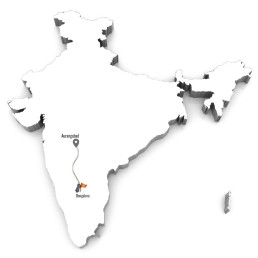
Jnana Yajna 40

Year & Dates:
May 14, 1958 to May 25, 1958

Yajna Topic:
Shrimad Bhagavad Gita- Chapter 12

Place:
Bengaluru, India.
With material progress, the concept of welfare has often overlooked a deeper, spiritual well-being. Having made an astute diagnosis before He undertook His Mission, Pujya Gurudev wanted the remedy from the scriptures to be distributed to all. So, on May 13, 1958, at a City Town Hall Meeting arranged by Chinmaya Mission, Bengaluru, He said: “In spite of the beautiful contributions made by science providing more and more comforts and amenities in the outer world, man is not happy today because of the maladjustments in his inner personality constituted by his own mind and intellect. He becomes a shattered personality and, like a man suffering from fever, he is not able to enjoy the ‘feast of life’ which the world provides for him. His heart contracts, and the intellect alone grows and ramifies…”
Developing the Heart
The 40th Jnana Yajna was arranged wishing for the true, wholesome welfare of over 5000 employees of Indian Telephone Industries Limited (now ITI Limited). And, Pujya Gurudev fittingly chose Bhagavad Gita Chapter 12 to revitalize the mind-intellect equipment.
On the evening of May 14th, inaugurating the yajna, Shri R.R. Diwakar, Chairman of the Gandhi Memorial Charitable Trust, pointed out that Hindu culture withstood the lashes of time only because of its spiritual roots. He added that the Gita was like a capsule encasing the curative essence of all Upanishads. Especially the Bhakti Yoga declared by Bhagavan Krishna in the 12th chapter presents a universal path accessible by all.
Pujya Gurudev, in His introductory discourse, cautioned that mere repetition of the mantras doesn’t strengthen spiritual culture. He defined Bhakti as an unmasking attunement with the Divine. Explaining thoroughly the unmanifest and manifest aspects of Bhagavan, along with the path, attitude, and attributes of a dear devotee, Pujya Gurudev indicated that developing the heart with divine love was equally important as advancing our intellect.
The audience of the 40th Jnana Yajna had the opportunity to express their devotion every evening. This is because of the bhajans they sang joyfully on the special buses while arriving into the ITI colony from all parts of Bengaluru.The other integrated features of the Jnana Yajna like the five -day Akhanda Kirtan, the Gita Havan, and the yatra to the sacred Arunaachala-Kshetra Tiruvannamalai for having the darshana of Arunaachaleshvara Bhagavaan also enriched the practice of devotion as learned from the Gita. On May 23, after the purifying Ganga sprinkling ceremony, Pujya Gurudev distributed about 1000 booklets of “Gayatri & Japa Yoga” to all the devotees, reminding that mantras and Japa gain potency only with devotion.
Photo Gallery

“Think,” Says Pujya Gurudev
Fix thy mind on Me Alone: The mind cannot contemplate on any theme that cannot be conditioned by the senses. Therefore, by meditation upon the enchanting form of the Immortal Flute-Player, the human mind can readily be made to rest entirely at the feet of the form. The Lord, being All-pervading, is at once the Divine Grace behind all names and forms. The mind of a devotee cannot wander to any place where he is not reminded of the smile of the Crowned Cowherd-boy!
From Shrimad Bhagavad Gita- Chapter 12, Book
Faith vs. Belief
Are belief and faith synonymous? Do our beliefs falter when confronted with life’s trials? Can we uphold faith even as our beliefs waver? Pause for introspection and contemplation as we explore the resilience and enduring strength of unwavering faith. Find answers to these inquiries and more in this enlightening discourse.
Jnana Yajna 39

Jnana Yajna 39

Year & Dates:
April 24, 1958 to May 10, 1958

Yajna Topic:
Shrimad Bhagavad Gita- Chapter 2

Place:
Aurangabad, India.
A gentle drizzle just before the inauguration of the 39th Jnana Yajna at Aurangabad, Maharashtra – it seemed like Varuna, the God of Rains, wanted to participate in Pujya Gurudev’s Gita Jnana Yajna. Unmindful of those sprinkles, an attentive audience awaited the glorious Chapter 2 of Bhagavan Krishna’s Eternal Song through the incomparable voice of Pujya Gurudev Swami Chinmayananda. After prayers at the nearby Khadkeshwar Shiva temple, the unfurled Om flag energized the atmosphere. Sri B. G. Ghate, the secretary of the yajna committee welcomed Pujya Gurudev and the gathering. And, Swami Ramanand Thirth inaugurated the yajna saying Gita showed the way to lasting happiness.
Opening His address with, “In this red-hot age of Sputniks and Hydrogen bombs, in this age of Science and Technology, in this age of Plans and Projects, you may be wondering why there are two Sadhus on the stage this day!” Pujya Gurudev attracted Aurangabad with His charming wit.
Through Heat and Rain
As Pujya Gurudev shifted into high gear in the discourses that followed, Nature too became intense. Aurangabad experienced an unusual heat wave, and then the skies poured. When the yajna committee tried to put up a shamiana (tent), their efforts were thwarted. Every evening, a storm brought down the new tent that had stood through a quiet day after being erected. Undisturbed by the onslaught of heat and rain, storm and thunder, Pujya Gurudev unfolded the exalted logic of Sankhya Yoga and Buddhi Yoga. Sheltered by His composure and immersed in the beauty of His exposition, the audience sat thrilled by the spiritual, intellectual, ethical, and traditional viewpoints that Pujya Gurudev presented.
Aurangabad is home to many artistic masterpieces. During this Jnana Yajna, Pujya Gurudev visited the acclaimed Ellora Caves, about 18 miles from Aurangabad. The aesthetic excellence of the Kailas Cave, in particular, launched Him into a state of supreme joy.
During the final days of the yajna, the Akhanda Kirtan from April 30th, the Gita Homa from May 2nd, and the Gangajal procession stirred devotion in all the awakened hearts of Aurangabad. The spiritual sojourn to the nearby town of Paithan and the Avabhruta Snanam in the Godavari river brought much happiness to devotees. Offering homage at the Samadhi shrine of the great saint of Maharashtra, Sant Eknath Maharaj was a fitting culmination. Pujya Gurudev, in yet another wonderful Jnana Yajna, demonstrated how the Gita view of life can certainly become a practical way of life.
Photo Gallery

“Think,” Says Pujya Gurudev
Yoga and Kshema in their meaning include all the activity of every living being on the face of the universe. These are the two urges which goad every one in all their activities. Yoga means ‘to acquire’ for the purpose of possessing them; and ‘kshema’ means ‘all efforts at preserving the acquired’. Thus the two terms Yoga and Kshema indicate all our ego-centric activities motivated by selfish desires to acquire and, compelled by equally selfish wishes, to hoard and preserve what has been acquired. To renounce these two temperaments is to immediately get away from the two main fields that yield the poisonous harvest of extreme restlessness and sorrow in life.
From Tyagi Magazine
Buddhi as defined in the Upanishad is a determining factor in the inner equipment; Nischayatmika is intellect; Samsayatmika is mind. Thus, when thoughts are in a state of flux and agitated it is called the mind; and when it is single-pointed, calm and serene in its own determination, it is the intellect. Thus Buddhi Yoga becomes “established in the devotion to intellect.” Steady in your conviction, your mind perfectly under the control of your better discriminative intellect, to live a master of your inner and outer work is called Buddhi Yoga.
From Tyagi Magazine
Embrace Death
Explore the profound wisdom behind the metaphor of death as a mere change in attire. In this insightful discourse, discover how the transition from one body to another is likened to shedding old clothes and donning new ones. Gain a deeper understanding of the timeless concept of mortality and the continuity of existence beyond physical form. Join us on a journey of contemplation and enlightenment as we delve into the eternal nature of change.

